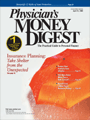Make the Case for Disability Insurance
Think about it:
Most Americans fear the loss oftheir possessions and thereforesee the need to insurethese possessions. Mostof us would agree that our homes cannotgo uninsured in case there is a fire,flood, hurricane, or major earthquake.But what are the chances we willencounter such a loss in our lifetime?When it comes to house fires, for example,1 in 1200 homes actually burndown. Of course, depending on whereyou live, you already know what risksyou face and what it costs to insureagainst such losses.
Now, let's consider a major nonmaterialloss. Statistics show that 1 in 8Americans will become disabled at somepoint in their working life. Unfortunately,the simple truth is, most physician-investorsnever consider short-term disabilityinsurance. Granted, it's not a funtopic to think about. However, it isextremely relevant in this day and age.
Doubting Dr. Smith
Let's assume that Dr. Smith lives in anew $500,000 home. The homeowner'sinsurance he pays each year (ie, between$3000 and $4000 with a $2500 deductible)covers the loss and possiblereplacement of the home. As we allknow, Dr. Smith's premiums can increasethroughout the years or his policy can becanceled. Still, in today's marketplace,we're lucky to have this type of coverage—and Dr. Smith knows it.
Consider the facts:
What he isn't sure about is disabilityinsurance. Despite statistics, Dr. Smithisn't convinced it's worth the money. So,is he correct in assuming it's too expensive?If he purchasesa Guaranteed Renewable Disability policywith Guaranteed Level Premiums toage 65, Dr. Smith's annual premium willbe about $3300 and his total potentialbenefits will be almost $4 million. Witha monthly benefit of $10,000, if he doesbecome disabled for 1 year, Dr. Smithwill receive $120,000 in total (ie,$10,000 x 12 months).
Providing Protection
Let's also assume that Dr. Smith, whois currently age 35, earns an annualsalary of $200,000 as a family practitioner.If that income level remains the sameuntil Dr. Smith turns age 65, his earningpotential will be around $6 million (ie,30 years x $200,000).
Now, if Dr. Smith's home burns downone day while he is at work, he has nothingto worry about because he is currentlycovered under his homeowner'sinsurance. But let's say he didn't havehomeowner's insurance. In this case,what would be the good doctor's fate? Ifwe consider his income potential to age65 ($6 million), it's very likely that Dr.Smith will find a banker who will lendhim the money to rebuild his home.
On the other hand, if Dr. Smithbecomes disabled, all bets are off.Without short-term disability insurance,the sad truth is that Dr. Smith could losehis house in a heartbeat. Just as withoutthe goose, there are no golden eggs,without disability insurance, there areno easy ways out.
has specialized
in disability insurance for
physicians since 1969. He has
authored many articles on this
topic, served as a guest speaker for
insurance companies and professional
organizations, and consulted with many
companies in the design of their disability products
for physicians. Mr. Cohen welcomes questions and
comments at ron@roncohenrhu.com, or for more
information, visit www.roncohenrhu.com.
Ron Cohen, RHU, RR,
